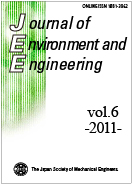Volume 6, Issue 4
Displaying 1-12 of 12 articles from this issue
- |<
- <
- 1
- >
- >|
Papers
-
2011Volume 6Issue 4 Pages 723-738
Published: 2011
Released on J-STAGE: June 23, 2011
Download PDF (969K) -
2011Volume 6Issue 4 Pages 739-752
Published: 2011
Released on J-STAGE: June 23, 2011
Download PDF (948K) -
2011Volume 6Issue 4 Pages 753-764
Published: 2011
Released on J-STAGE: July 07, 2011
Download PDF (601K) -
2011Volume 6Issue 4 Pages 765-777
Published: 2011
Released on J-STAGE: July 07, 2011
Download PDF (968K) -
2011Volume 6Issue 4 Pages 778-791
Published: 2011
Released on J-STAGE: August 03, 2011
Download PDF (997K) -
Quenching of Self-Excited Sounds Generated from Two Helmholtz Resonators by Use of a Connecting Tube2011Volume 6Issue 4 Pages 792-804
Published: 2011
Released on J-STAGE: August 03, 2011
Download PDF (719K)
Review Paper
-
2011Volume 6Issue 4 Pages 805-819
Published: 2011
Released on J-STAGE: September 07, 2011
Download PDF (1551K)
Papers
-
2011Volume 6Issue 4 Pages 820-829
Published: 2011
Released on J-STAGE: September 09, 2011
Download PDF (597K) -
2011Volume 6Issue 4 Pages 830-845
Published: 2011
Released on J-STAGE: November 08, 2011
Download PDF (468K) -
2011Volume 6Issue 4 Pages 846-860
Published: 2011
Released on J-STAGE: November 16, 2011
Download PDF (2214K) -
2011Volume 6Issue 4 Pages 861-868
Published: 2011
Released on J-STAGE: November 30, 2011
Download PDF (355K) -
2011Volume 6Issue 4 Pages 869-881
Published: 2011
Released on J-STAGE: November 30, 2011
Download PDF (3259K)
- |<
- <
- 1
- >
- >|
